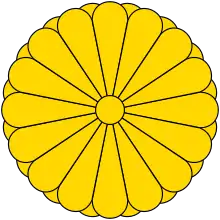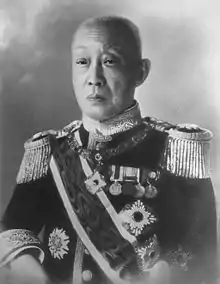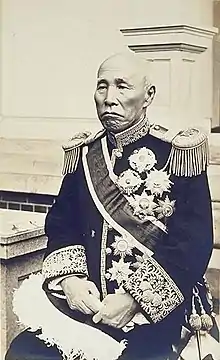1903 Japanese general election
General elections were held in Japan on 1 March 1903.[1] The Rikken Seiyūkai party remained the largest in the House of Representatives, winning 175 of the 376 seats, but lost its majority.
| ||||||||||||||||||||||||||||
All 376 seats to the House of Representatives 189 seats were needed for a majority | ||||||||||||||||||||||||||||
|---|---|---|---|---|---|---|---|---|---|---|---|---|---|---|---|---|---|---|---|---|---|---|---|---|---|---|---|---|
| ||||||||||||||||||||||||||||
_1903.svg.png.webp) House of Representatives conformation | ||||||||||||||||||||||||||||
| ||||||||||||||||||||||||||||
 |
|---|
| This article is part of a series on the politics and government of Japan |
|
|
Electoral system
The 376 members of the House of Representatives were elected in 51 multi-member constituencies based on prefectures and cities. Voting was restricted to men aged over 25 who paid at least 10 yen a year in direct taxation.[2]
Campaign
A total of 537 candidates contested the 376 seats.
Results
| Party | Votes | % | Seats | +/– |
|---|---|---|---|---|
| Rikken Seiyūkai | 373,022 | 45.6 | 175 | –16 |
| Kensei Hontō | 218,689 | 26.7 | 85 | –10 |
| Chūsei Club | 37,070 | 4.5 | 31 | New |
| Teikokutō | 34,811 | 4.3 | 17 | 0 |
| Seiyū Club | 24,129 | 2.9 | 13 | New |
| Jinin Kai | 2,748 | 0.3 | 0 | –28 |
| Dōshi Club | 1,517 | 0.2 | 0 | –13 |
| Others | 129,313 | 15.4 | 55 | +23 |
| Invalid/blank votes | 7,527 | – | – | – |
| Total | 825,826 | 100 | 376 | 0 |
| Registered voters/turnout | 958,322 | 86.2 | – | – |
| Source: Mackie & Rose, Voice Japan | ||||
References
- Thomas T Mackie & Richard Rose (1991) The International Almanac of Electoral History, Macmillan, p281
- Mackie & Rose, p276
This article is issued from Wikipedia. The text is licensed under Creative Commons - Attribution - Sharealike. Additional terms may apply for the media files.

